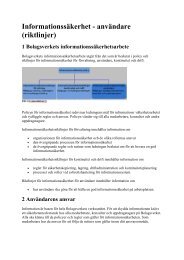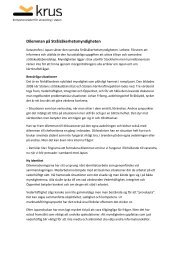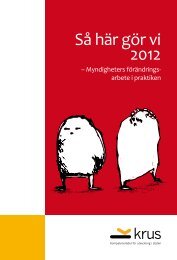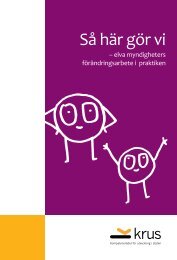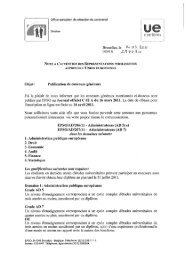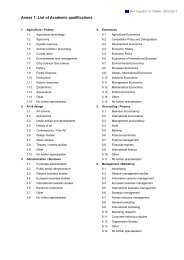Dialogkompetens i skolans vardag - Publikationer - LTU - Luleå ...
Dialogkompetens i skolans vardag - Publikationer - LTU - Luleå ...
Dialogkompetens i skolans vardag - Publikationer - LTU - Luleå ...
You also want an ePaper? Increase the reach of your titles
YUMPU automatically turns print PDFs into web optimized ePapers that Google loves.
part in communication where the language is chosen on the basis of situation and<br />
environment.<br />
The pupils use hearing aids as personal aids 43 . To correct impaired hearing by<br />
means of a hearing aid is not like correcting impaired vision by means of spectacles.<br />
The hearing aid cannot restore hearing like a normal ear, since it cannot distinguish<br />
sounds in the same way. To concentrate on what is being said, the person<br />
is forced to screen out irrelevant sounds. Listening situations in noisy environments<br />
can require so much energy that people sometimes choose to assume a passive<br />
role (Arlinger, 1999; Gullacksen, 2002).<br />
The traditional technological solution in classrooms has been individual microphones<br />
on each pupil’s desk (Figure 1). The microphones are activated by mechanically<br />
pressing a button. The technical equipment is tied up to the room and,<br />
through fixed cables; it also determines the arrangement of the furniture. The<br />
technology that was used in the project was a cordless conference system lying on<br />
the desk (Figure 2). This is a flexible system that can be carried to other rooms. In<br />
both cases the teacher can choose to have a microphone round her/his neck.<br />
Figure 1. Traditional Technology<br />
Figure 2. Technology tested within the project.<br />
In multi-voice environments, the oral and written dialogue is there as a basis for<br />
jointly developing knowledge (Dysthe, 1996). For hard-of-hearing pupils the oral<br />
43 Most pupils taking part in the study had traditional hearing aids, but there were also pupils with<br />
cochlear implants (CI). Both alternatives are personal aids and may be regarded as different forms<br />
of hearing aids. A CI is operated into the cochlea, and for children with a CI, training of speech<br />
and the ability to perceive speech is emphasized (cf. Preisler, Tvingstedt & Ahlström, 2003; Roos<br />
& Fischbein, 2006).<br />
93



